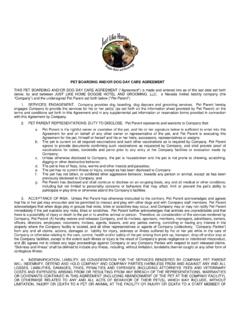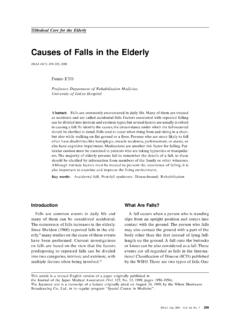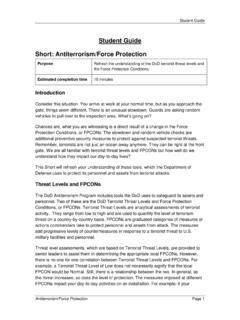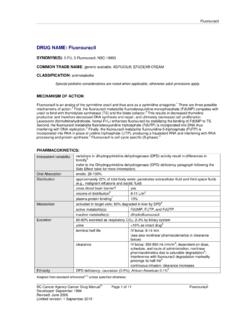Transcription of Attachment, what it is, why it is important and what …
1 SUMMARYWhat is attachment theory ? attachment theory is based on findings from empirical research,from observational studies and from clinical examples; it s a framework for understandingthe nature of the enduring family bonds that develop between children and their parents -their attachment figures. The theory focuses mainly on relationships during early childhood,and the impact that these have on the emotional development and mental health of childrenas they and toddlers have a powerful survival reaction to sense danger whenever they are inunfamiliar places and have no access to an attachment figure, preferably to their primaryattachment figure (who is usually but not necessarily their biological mother).
2 This sense ofdanger frightens children and triggers their attachment seeking response, and this responsewill be terminated only when they reach proximity to their attachment figure. Theattachment response starts at about 6 months, peaks between 12 and 24 months, and by 36months the intensity has reduced sufficiently that most children can tolerate a few hoursseparation from attachment figures without distress - during pre-school nursery forexample. A secure attachment is likely to develop when an adult is sensitive and attuned to the baby scommunications, and when the adult provides consistent and predicable care which meetsthe needs of the baby quickly and reliably.
3 An insecure attachment is likely to develop when the adult is insensitive and not wellattuned to the baby s communications, and when the care is inconsistent and unpredictableand does not satisfy the baby s needs quickly or change from insecure to secure knowledge, no one has found a magic bullet for instantly switching insecureattachment into secure attachment . The most common origin of children s insecureattachment is the intergenerational transmission of insecure relationships. Most of theeffective interventions (such as attachment based family psychotherapy) aim to resolve oldattachment issues from previous from insecure to secure attachment is slow, expensive and takes very skilfultherapists, and the cure is never complete - at times of stress, ghosts from the nursery return to haunt people.
4 Prevention is infinitely preferable to , what it is, why it is important and what we can doabout it to help young children acquire a secure attachmentby Sir Richard Bowlby from the attachment theory : How to help young children acquire a secure attachment11 7 Sir Richard Bowlby gave a verbal presentation on the theme of attachment to the Quality ofChildhood Group in the European Parliament on 8th January 2008. Notes taken during thepresentation were formulated into the report below, which has been checked and approvedby Sir Richard Bowlby retains copyright and reproduction rights over his original text (aspresented), and remains free to have his original text published elsewhere or put onto theinternet for unrestricted theory : How to help young children acquire a secure attachment11 6 attachment theory : How to help young children acquire a secure attachment11 8 The age that a young child is ready to leave the home.
5 33 monthsMaria Montessori, in the 1930 s in Italy, found that children were ready to go to pre-schoolnursery at the age of 2 years and 9 months. Present day brain research indicates that at thisage the right brain is ready for emotional and intuitive activity and the left brain enables thechild to speak with three words and it can remember the past (for instance that mum willcome back ). When we look at this situation it becomes clear that developments in society will force us togo back (or forward) to a situation where the child will again receive care of a good qualityduring the first phase of his /her life. This may be an inconvenient truth, but we have to faceit.
6 What Is attachment theory ?Before talking about attachment theory , I need to tell you what attachment is. My fatherused the term attachment to describe the affectional bonds that develop between babiesand their mothers. Most people call these family bonds love - the sort of family love that sdifferent from sexual love .Based on empirical researchAttachment theory is based on findings from empirical research, from observational studiesand from clinical examples; it s a framework for understanding the nature of the enduringfamily bonds that develop between children and their parents - their attachment theory focuses mainly on relationships during early childhood, and the impact thatthese have on the emotional development and mental health of children as they grow the mental health of children today better than 50 years ago?
7 Many psychologistsrespond with no . In times of danger babies and toddlers seek their mother/ primary attachment figureBabies and toddlers have a powerful survival reaction to sense danger whenever they arein unfamiliar places and have no access to an attachment figure, preferably to their primaryattachment figure (who is usually but not necessarily their biological mother). This senseofdanger frightens children and triggers their attachment seeking response, and thisresponse will be terminated only when they reach proximity to their attachment seeking is a specific response requiring a specific termination - proximity to anattachment figure.
8 Similar behaviours (usually called imprinting) can be observed in theyoung of many other species and it s a very successful survival strategy. For example, if youwatch a herd of elephants protecting newly born baby elephant from a group of lions, theydosuch a good job that: the lions do not have not a theory : How to help young children acquire a secure attachment11 9 attachment response: when it starts and when it peaksThe attachment response starts at about 6 months, peaks between 12 and 24 months, andby 36 months the intensity has reduced sufficiently that most children can tolerate a fewhours separation from attachment figures without distress - during pre-school nursery forexample.
9 The quality of this enduring mother/child bond will have a significant impact on the child sdeveloping personality and future social, emotional and mental wellbeing By their fifth birthday most children can manage five short days of school. Attachmenttheory concentrates mainly on the bond that a mother has with her child, and on theattachment that a child has with their mother or the person who raises them. The qualityand nature of this enduring mother/child bond will have a significant impact on the child sdeveloping personality and future social, emotional and mental wellbeing - for better or quality of the attachment has a very significant influence on how children build futurerelationshipsA child s primary attachment figure is usually the biological mother, but the biological linkis not essential.
10 In many cases someone else raises the child and becomes the primaryattachment figure - such as when a child has been adopted or raised by the father orgrandmother. A baby sometimes becomes primarily attached to a temporary carer, a nannyfor example, instead of to their own mother, and the child experiences a traumatic loss ifthe nanny leaves and the primary attachment bond is broken. But most people have anenduring attachment bond with their mother that lasts a lifetime, and the quality of thisrelationship has a very significant influence on how they build future development of babies primary attachment bond can be compared to the developmentof speech.





